15 Best Barefoot Hiking Shoes & Boots (That Actually Fit Real Feet)
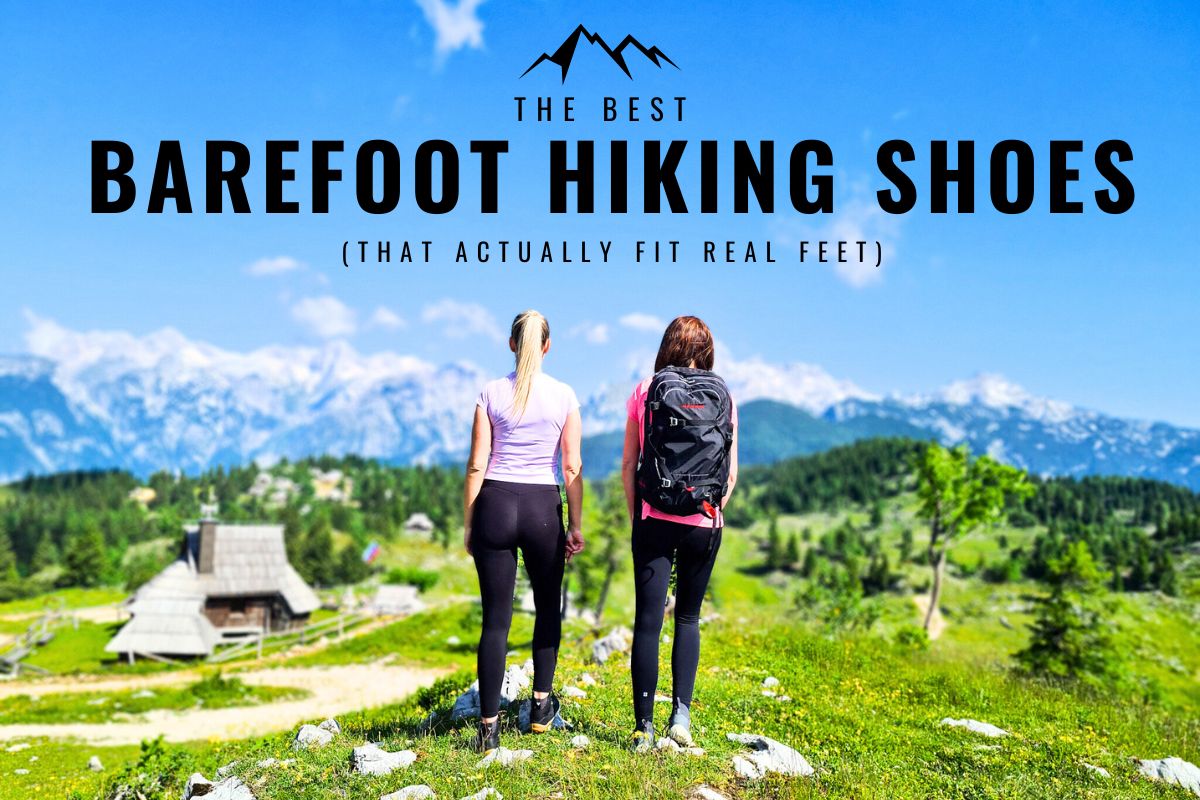
Looking for the best barefoot hiking shoes and boots that actually fit real feet? You’re in the right place.
Most traditional hiking shoes are stiff, narrow, and overbuilt, leaving your toes cramped and your feet disconnected from the ground. That’s where barefoot hiking shoes and boots come in.
So we’ve done the legwork (literally!) to bring you a list of the best barefoot hiking shoes and boots – options with wide toe boxes, flat soles, flexible designs, and everything your feet need to move naturally on the trail.
Whether you’re climbing rocky paths, wandering muddy forest trails, or just want a minimalist boot for everyday wear, you’ll find something that works for your foot shape and hiking style.
In this guide, we’re highlighting some of the best barefoot hiking shoes and boots, like the Vivobarefoot Tracker, Freet Bootee, Be Lenka Trailwalker, Xero Shoes Scrambler Mid, and Proalp Contact S2—all designed to let your feet move naturally and comfortably over any terrain.
If you’re new to this, don’t worry – we’ll walk you through what to look for and how to find a shoe that fits your foot and your trail.
Not sure if barefoot hiking is right for you? Read this first → Are Barefoot Shoes Good for Hiking?
What Makes a Great Barefoot Hiking Shoe?
Before we dive into specific models, let’s quickly cover what defines a great barefoot hiking shoe or boot.
These are the key features we look for when testing and recommending trail-ready barefoot footwear:
✅ Zero-drop sole – no height difference between heel and toe for natural alignment
✅ Wide toe box – allows your toes to spread out instead of squeezing them together
✅ Flexible sole – lets your foot bend and respond to uneven terrain
✅ Secure fit – keeps your foot stable on rocky or steep trails
✅ Durable outsole with good grip – essential for safety and long-term performance
✅ Weather protection – optional, but useful for cold, wet, or muddy conditions

⚠️ Note: Barefoot hiking shoes vary in sole thickness. Some are ultra-thin for maximum ground feel, while others offer a bit more cushion for long distances or rugged trails. The right choice depends on your terrain, experience, and preferences.
That’s why we’ve organized this list by sole thickness – because how much ground feel you want (and how much protection your feet need) can really change your hiking experience.
Our recommendations are based on real-life testing to help you find the best barefoot hiking shoes and boots for your feet and terrain:
- Total Shoes Tested: 14 different brands (20+ models)
- Testing Period: 6-24 months per shoe
- Selection Criteria: Fit, comfort, durability, traction, barefoot design features, sole thickness, and weather suitability
- Last Updated: April 3, 2025
- Reviewer’s Foot Size: 26.3 cm (length) / 10 cm (width)
- Size Tested: Typically EU 42 or EU 43 (varies by brand)
- Width Category: Foot width: 10 cm (medium); Shoe width: Varies by brand
- Other Sizes Available: EU 36–49 (varies by brand)
⚡ Quick Note: Every barefoot hiking shoe in this post has been personally tested by our team on actual hikes in real conditions.
Best Barefoot Hiking Shoes with Minimal Cushioning
(Medium sole thickness – best balance for hiking, all-rounders)
These barefoot hiking shoes and boots strike the perfect balance between trail protection and natural movement. The soles are still flexible and zero-drop (so you stay connected to the ground) but they include either a slightly thicker base or a soft insole to help reduce the bite of sharp rocks and rough terrain.
That little bit of extra cushion goes a long way on longer hikes, making these options ideal for most people, especially if you’re transitioning from traditional hiking boots or want something that works for a variety of trail types.
VIVOBAREFOOT Hiking Shoes



Use BU15 for 15% discount
VIVOBAREFOOT has long been one of the most trusted names in barefoot hiking – and for good reason. They offer a wide range of trail-ready boots and shoes, from breathable low-cut models to insulated waterproof boots.
One of our favorite all-rounders is the Tracker Forest ESC. It’s waterproof and grippy, especially on loose and muddy ground, though it can be a bit slippery on wet roots and rocks. If you’re after something more flexible and packable, the Magna Lite is a great lightweight option with a stretchy upper and easy slip-on feel. For low-cut lovers, the Primus Trail is a solid choice for forest walks and dry trails.
VIVOBAREFOOT also uses different outsoles across their models, like Soft Ground, Firm Ground, and ESC, so you can choose what works best for your terrain. Leather models tend to perform better when it comes to sweat and breathability. The vegan options are functional, but they can run hot and feel less breathable over long distances.
Sizing & Fit:
- Toe box is fully foot-shaped but not the widest out there – check your foot width here to see if they’ll work for you
- Best for narrow and medium-width feet
- Men’s sizing = slightly wider than women’s (including the midfoot and heel)
- True to size chart (I wear a size EU 42 with a foot size of 26.3/10 cm, but in terms of width, the women’s models are already too narrow for me)
Want to learn more about sizing, outsole types, and specific models? Check out our full VIVOBAREFOOT review here.
Xero Shoes Scrambler and Scrambler Mid Hiking Shoes




Xero Shoes offers a wide range of barefoot hiking shoes and boots, but our top picks for trail performance are the Scrambler Low and Scrambler Mid. (Looking for something more cushioned? Check out our review of their Ridgeway model here →)
Both Scrambler models feature a Michelin outsole with 3mm lugs, offering excellent traction and durability for rocky and uneven terrain. The sole has less softness and give than some other brands on this list, which can be a plus if you prefer a firmer and cushioned feel underfoot or want a bit more protection over long distances.
The Scrambler Mid II has a breathable upper and a firmer heel cup than what we typically see in barefoot shoes. It might feel restrictive at first, especially if you’re used to softer, more flexible heels. But it does come with top speed hooks for fast, adjustable lacing that helps prevent foot slide on descents.
Fun fact: On a windy spring day, I could literally feel the breeze blowing through the shoe—these are some of the most breathable hiking boots we’ve tested!
If you need a waterproof option, the Scrambler Mid WP holds up well in wet conditions (we tested it by walking through streams), though it can feel warmer and less breathable due to the membrane.
If you prefer a low-cut style, the Scrambler Low offers the same grippy outsole with a more breathable, trail-runner feel. It’s available in a few fun colors too, if you’re not into the all-black hiking boot look.
For fully waterproof trail running shoes, the Mesa Trail WP is another option – but be aware, they tend to trap heat and can make your feet sweaty, especially in warmer weather.
Sizing & Fit:
- Best for narrow and medium-width feet (leaning towards narrow)
- Overall straight shape with more width and volume in the midfoot and heel
- Men’s models are wider than women’s
- Work well for various foot volumes, but the toe box can feel roomy for narrow, low-volume feet
- Runs true to the size chart (except the Mesa Trail WP, which runs slightly short)
- I usually size up ½ to 1 full size to get enough width and toe space (wearing EU 42 with foot dimensions 26,3/10 cm)
Want more details on sizing, models, and comparisons? Check out our full Xero Shoes review here.
Freet



Use code bu-freet for 10% discount
Freet offers several models designed specifically for hiking, all built on one of three different outsoles, depending on the terrain:
- MountainGrip – 6mm tread for excellent traction in mud and off-trail use
- HillGrip – Deep 4mm lugs with an aggressive pattern for grip on steeper, wetter ground
- TrailGrip – 3mm tread, great for all-round use on trails and in everyday life
All of their soles are soft and flexible, with a removable foamy insole that adds just the right amount of cushioning. It’s a great setup if you want a comfortable barefoot shoe that still takes the sting out of long, rocky hikes.
For summer hikes, our personal favorites are the Feldom and Calver – lightweight, breathable, and super easy to clean (yes, you can toss them in the washing machine!). When the weather turns colder, models like the Bootee, Mudee, and Impala are more protective and insulated.
Freet uses both leather and vegan materials. While their vegan microfiber uppers are easy to maintain, they can run warm in hot weather. In contrast, the leather-lined versions offer better breathability and feel less sweaty when temperatures rise.
Most of their hiking boots don’t fully cover the ankle – they sit around mid-ankle height, which helps reduce restriction while still offering some coverage and structure. And thanks to their flexible build, they feel much more natural than traditional hiking boots.
Sizing & Fit:
- Suitable for medium and wide feet (though newer models tend to run narrower – I usually size up one full size in models with thicker lining)
- Most styles work well for different instep heights and foot shapes
- Fit can vary slightly by model (check individual specs for the best results)
Want to dive deeper? Read our full Freet brand review here →
Proalp Contact S2



Use BU5 for 5% discount
Proalp hiking boots are a solid choice if you’re looking for a rugged barefoot option with great traction and customizable details. Handmade in Slovenia (our home country, with plenty of beautiful mountains to test them in!), these boots are built with durable leather upper, Vibram outsoles, and a good balance of flexibility and support – ideal for technical hikes or alpine terrain.
They come in three different widths, and the widest version fits extra wide feet comfortably, which is a big win if you usually struggle with narrow hiking boots. You can also personalize your pair by choosing the color, materials, and whether or not you want the top velcro strap. They come with removable wool insoles that add warmth and a bit of cushioning, though they do take up some space inside the shoe.
While they’re not fully waterproof, the leather is naturally water-repellent and can be treated with waterproofing spray for added protection. This gives you solid water resistance without compromising breathability.
Sizing & Fit:
- Available in men’s and women’s sizes
- Offered in three widths
- Ideal for narrow to extra-wide feet (in the widest width)
- Best for narrow or average heels and ankles and low and average foot volume
- Comes with wool insole – remove if you need more space or greater ground feel
Be Lenka



Use BU5 for 5% discount
Be Lenka has two dedicated hiking models: the Trailwalker 2.0 and the Ranger, both built on a fully foot-shaped sole with lots of space for your toes.
The Trailwalker 2.0 is an ultralight, low-cut barefoot hiking shoe that’s ideal for spring and summer hikes. It has a soft, flexible sole with just enough grip for forest paths and casual trails, and the reinforced rubber sidewall adds durability. The insole adds a bit of cushion, making them more forgiving for longer hikes, but you can also remove it for maximum ground feel. Without the insole, the toe box feels extra roomy, even above the toes, which is great for wider feet or wearing them with toe socks. It’s breathable, comfortable, and with included insole a great pick for those who want a natural feel underfoot without going super thin.
For colder months or damp conditions, the Be Lenka Ranger is a solid alternative. It’s a fleece-lined, water-resistant hiking boot with a high-top design for extra warmth. Out of the box, it can feel a bit firm, but it softens up after some wear. The outsole is grippy and stable on mixed terrain, but the insulation makes it a bit too warm for year-round hiking. If you’re after a minimalist boot for cold-weather adventures or winter walks, this is a great option.
Sizing & Fit:
- Fits medium and wide feet well
- Runs true to the size chart, but I sized up in both models (adding approx. 15–17 mm of extra space in front of my toes)
- Ranger fits best on low and average foot volume
- Trailwalker has more volume when the insole is removed (especially above the toes) and works well for higher volume feet too
Want more details? Check out our full Be Lenka review here →
See how Ranger compares to other winter barefoot boots in our Best Everyday Barefoot Boots Guide →
BÄR Shoes



Use BU10 for 10% discount
If you’re looking for premium-quality barefoot hiking shoes that can handle serious miles and still feel good at the end of the day, BÄR Shoes is worth checking out.
Their Mountain Barefoot hiking boot is a great choice for hikers who want natural foot movement with a touch of structure. It has a unique sole that wraps around the midfoot. I was initially worried it might feel like arch support, but it doesn’t. Instead, it offers a bit of lateral stability on uneven terrain while still keeping the feel minimal. The sole is thin with little cushioning, and the ankle remains unrestricted. The lacing system is smooth and easy to adjust.
For warmer weather, the low-cut Light Flex version is a great companion – lightweight, breathable, and just as foot-friendly.
BÄR also offers several other waterproof wide toe box hiking shoes and boots with a thicker sole, making them a solid pick for anyone who prefers more cushioning and protection. They’re especially good for beginners transitioning to barefoot shoes, or for long-distance hikes where a bit more shock absorption is helpful.
Sizing & Fit:
- Available in half sizes for a more precise fit
- Best suited for medium-width feet
- Men’s versions have slightly more volume in the toe and midfoot than women’s
- I sized up by ½ size to allow extra room for thicker socks and foot swelling on long hikes
- An excellent choice for average foot volume
Softstar Shoes



The Softstar Switchback is a beautifully crafted barefoot hiking boot that combines premium materials, a foot-friendly shape, and a rugged Vibram™ Megagrip sole for confident grip on a variety of terrain. It comes in two different widths, but only the ‘Wide’ version is fully foot-shaped.
You can choose between two upper options: SuperFabric and full leather. The SuperFabric version is marketed as highly water-resistant, but in our testing, the shoes did get damp inside after a couple of minutes in water.
The sole is on the thicker side, offering a bit of give underfoot and noticeably more cushioning than some other barefoot options on this list. Still, you maintain a good connection to the ground.
That said, I did experience some Achilles discomfort on a long downhill hike due to the back collar. A little lace tweaking helped, but it’s a reminder to make sure you have enough toe space and adjust the fit well before hitting a steep trail.
The Vibram sole does what it promises – fantastic traction on wet and dry terrain alike—and the overall feel is protective without being clunky. If you want something built to last with a bit more structure, the Switchback is a solid pick.
Sizing & Fit:
- Available in Regular and Wide widths (only Wide is fully foot-shaped)
- Best for narrow to average heels and ankles
- Works well for low and medium instep heights, but not ideal for high-volume feet
- Runs true to size, but we recommend sizing up, especially if you wear thicker socks or are near the upper end of a size range
- The space above the toes is somewhat limited, which can impact overall spaciousness
Want more details? Check out our full Softstar Switchback review here →
Saguaro



Use BU20 for 20% discount (new costumers)
Use BU15 for 15% discount (existing customers)
If you’re looking for an affordable barefoot hiking shoes, Saguaro is one of the most budget-friendly brands out there. They offer a mix of low-cut barefoot hiking shoes and mid-height waterproof boots, making them accessible for casual hikers or those just starting their barefoot journey.
Saguaro frequently updates and rotates their models, so specific features and shapes may vary over time. The grip is decent, and while the materials don’t match the premium feel of higher-priced brands on this list, they still do the job, especially for less technical terrain.
Whether you’re looking for something lightweight to toss in your backpack or an inexpensive way to test out barefoot hiking, Saguaro is a solid entry point.
Sizing & Fit:
- Best for medium-width feet (but some variation in fit between models due to frequent updates and different sole shapes)
- Works well for different foot volumes
- Different sole shapes across models – some are more tapered than others
- I usually size up for a better fit
Realfoot


Use 10BU for 10% discount
If you want a hiking shoe with a seriously wide toe box, Realfoot is hard to beat. The Trekker model has been one of our go-to recommendations for people with extra-wide feet who want something that feels truly barefoot but still protective enough for hikes and everyday wear.
These shoes are waterproof, with a gusseted tongue and a flexible sole that offers great ground feel. They come with a removable insole, which adds a bit of shock absorption. We’ve worn them for everything from muddy forest trails to city walks, and they’ve held up well.
However, they don’t have deep lugs, so they’re not the best choice for steep or slippery terrain.
Sizing & Fit:
- Best suited for wide and extra-wide feet
- Fit narrow to average heels and ankles well
- If you have a high-volume midfoot or heel, they might feel snug in those areas
- The toe box tapers slightly earlier at the big toe, so if your big toe is dominant, consider leaving extra space in front
- True to size chart, but make sure to factor in socks or insoles when choosing your size
Best Barefoot Hiking Shoes with Super Thin Soles
(For experienced hikers who want maximum ground feel)
These are for barefoot hiking purists who want to feel every root and rock. Ideal for natural terrain, forest trails, and hikers who already have strong feet.
Ahinsa Shoes



Use BU10 for 10% discount
If you’re after a super lightweight barefoot hiking shoe that’s 100% vegan, Ahinsa’s Chitra Trek & Trail is one of our top picks—especially for spring and summer hiking.
The barefoot version comes with an ultra-thin, removable insole and gives you tons of ground feel, while the Comfort version includes a lightly cushioned insole with a slight heel rise (so it’s not truly barefoot, but still foot-shaped). Both versions are soft, super flexible, and feel more like a barefoot sneaker than a rugged hiker – perfect if you value freedom of movement and aren’t tackling steep or rocky terrain.
If you’re looking for a waterproof barefoot hiking boot, check out their Hiker model. It’s surprisingly lightweight for a boot, has deep lugs with great grip, and also comes in an xWide version – ideal if you want more ankle protection or plan to hike in wet and muddy conditions.
One thing to note: the synthetic vegan upper isn’t breathable enough to go sockless, especially in warm weather. I’ve found that wearing toe socks makes a big difference in comfort and prevents the insole from sticking to the foot. But if ground feel and softness are what you’re after – and you want to avoid animal products – Ahinsa really delivers.
Sizing & Fit :
- Fits medium and wide feet
- Extra-wide version available for extra wide feet
- Works best for low and average foot volume
- Runs true to size chart – I wear size 43 with foot dimensions 26.3 / 10 cm
Saltic



Use BAREFOOTUNIVERSE10 for 10% off
Saltic’s barefoot hiking shoes are a bit under the radar, but they’ve earned their spot on our list. Made from durable leather with a protective rubber edge, they’re built to handle scrapes and rugged trails without adding bulk.
Their low-cut hiking shoes remind us a bit of the Be Lenka Trailwalker in terms of design, but Saltic gives you more ground feel – there’s no added insole, and the sole is very thin. It’s not overly soft or squishy, though. It has a slight firmness that some hikers might actually prefer, especially if you want more feedback from the ground without feeling every single pebble.
They don’t have deep lugs, but the traction is surprisingly good, even on uneven or mildly slippery surfaces. Plus, big pull tabs on the heel make them super easy to slide on and off.
One thing to note if you’re eyeing their OUTDOOR High model – I did run into a bit of Achilles discomfort when I first wore them. The back edge of the boot pressed into my Achilles tendon on downhill walks, which took a bit of adjusting. That said, the low-cut version didn’t cause the same issue and felt comfortable straight out of the box.
One quirky thing to note: the tongue is sewn in on one side, which helps keep it in place but also takes a little getting used to when putting them on.
Sizing & Fit:
- Runs true to size chart
- Best for medium-width feet
- Ideal for average foot volume
Best Wide Toe Box Hiking Shoes (with Thick Soles)
(Zero-drop options that aren’t fully barefoot but great for cushioning & toe freedom)
Not quite barefoot, but still offering flat soles and wide toe boxes – these are ideal for hikers who need more cushion without giving up natural foot shape.
Lems Shoes



Use BU10 for 10% off at Lems EU
If you’re looking for a more cushioned hiking shoe with a wide toe box but aren’t quite ready for the thinnest barefoot soles, Lems is a great in-between. Their shoes aren’t fully barefoot – there’s more sole underfoot and a bit more structure – but the flat base and roomy front still make them a favorite for minimalist hikers who want extra comfort.
Right now, they have three models suited for hiking: Outlander, Primal Pursuit, and Primal Pursuit Mid.
- The Outlander is their waterproof hiking boot – rugged, grippy, and surprisingly stylish for something this functional. It’s well-suited for rainy hikes and rougher terrain thanks to the deep tread and gusseted tongue.
- The Primal Pursuit is more of a hybrid sneaker-hiker. It’s low-cut, breathable, and feels great for casual hikes or warm-weather trails. The Mid version adds some ankle coverage and water resistance.
The sole is noticeably thicker than others in this list, so you don’t get the same ground feel, but it definitely adds a layer of protection and shock absorption. If you’ve had foot pain before or just like a bit of cushion, that can be a big plus.
Just note—while Lems shoes are wide at the toes, the hiking line isn’t the widest in their collection, and the taper can feel limiting for wider feet.
💡 Good news for EU customers: Lems now has a European warehouse, so shoes are shipped directly from within the EU—no customs fees or long wait times!
Sizing & Fit:
- Runs small – we recommend sizing up (follow their sizing guide carefully)
- Works well for narrow and medium-width feet, with a little extra space above the toes
- Great fit for different foot volumes
Bahé



Use BU10 for 10% discount
If you’re looking for a thicker wide toe box hiking boot that still respects your natural foot shape, Bahé is a solid pick – especially for beginners or anyone who prefers a bit more cushioning underfoot.
Bahé makes the first-ever grounding barefoot hiking shoes, combining a zero-drop sole, a genuinely wide toe box, and deep tread for reliable grip on rough terrain. The sole is definitely on the thicker side for a barefoot shoe, which means you won’t get a ton of ground feel – but it’s a great choice if you’re transitioning from conventional hiking boots or planning longer hikes where extra protection helps.
That said, if you’re used to super thin, ultra-flexible soles, the firmer heel and slightly rigid feel underfoot might feel a bit bothersome.
One of our favorite design elements is the ankle cut. It offers just enough structure without locking your ankle in place – a rare combo that allows natural movement without sacrificing support.
The upper feels secure and durable, and the grippy outsole handles gravel, dirt, and slick terrain with confidence thanks to its deep lugs.
Sizing & Fit:
- True to size chart
- Best for medium and wide feet
- Generous space above the toes
- Works best for average foot volume
Xero Shoes Ridgeway



If you’re looking for a barefoot hiking boot with a retro vibe, a wide toe box, and a thicker, cushioned sole, the Xero Shoes Ridgeway line might just be the sweet spot. It’s a solid pick for anyone easing into barefoot hiking or wanting more protection on longer hikes and everyday adventures.
The Ridgeway boot features a combo of canvas and suede, plus waterproof construction with a gusseted tongue. The sole is thicker and stiffer than many other barefoot boots on this list, which can feel more comfortable if you’re used to traditional hiking boots – but don’t expect the same level of ground feel as Xero’s more minimal options like the Scrambler.
My husband tested the Ridgeway Mesh Low and immediately claimed them as his go-to work and everyday shoe. They look mainstream enough to fly under the radar, but still give you the benefits of a flat sole and roomy toe box. He liked the versatility but noted that the sole felt firmer and thicker than his preferred Xero HFS II model. I tried them too and found the collar pressed a bit on my ankle, though he didn’t notice it at all – so fit can vary depending on foot shape.
If you’re someone who’s just starting with barefoot shoes or simply prefers more cushioning, these are a great choice—whether in the boot or low-cut version.
Sizing & Fit:
- Best for narrow and medium-width feet
- Fits true to size, but we recommend sizing up ½ to 1 full size, especially if you want more width or wear thicker socks
- Mesh Low version fits like most Xero shoes
- Boot version may feel a bit roomier in the midfoot (not ideal for narrow ankles or low volume feet without adjustments)
Barebarics



Use BU5 for 5% discount
If you’re after wide toe box hiking shoes or boots with cushioning, Barebarics (a sub-brand of Be Lenka) offers a great crossover option – especially for casual hikers or anyone easing into barefoot-style shoes from traditional footwear.
They currently offer two models:
- Voyager – a low-cut spring/summer hiking shoe with a stretchy mesh upper
- Trekker – a more structured hiking boot with ankle coverage and deep tread
Both have thicker, cushioned soles that feel closer to conventional shoes in terms of shock absorption. You won’t get that barefoot ground feel here – but you will get toe freedom and zero drop, which makes them great transitional models.
The grip is solid, and the build quality feels durable enough for weekend hikes, city walks, or light trail use. We personally wouldn’t take these on technical mountain trails, but for mellow hikes and everyday outdoor wear, they’re a comfortable choice.
Sizing & Fit:
- Great for medium-width feet
- Voyager has a lower volume fit, better for slim feet or those not needing much vertical space
- Trekker fits average foot volume well, with a bit more room above the toes
- True to size chart, but sizing up can help you get some extra width
Best Barefoot & Minimalist Hiking Shoes for Kids
We hike as a family, so finding proper barefoot shoes for our kids is just as important as for us adults. Kids need plenty of toe space, ankle mobility, and lightweight soles – especially when they’re exploring uneven ground or walking for longer stretches.
Kids’ barefoot hiking shoes don’t need to be overly built-up. In fact, a flexible, low-cut shoe with a grippy sole and proper foot shape is often the best choice. Here are a few of our top-tested picks:
VIVOBAREFOOT Kids
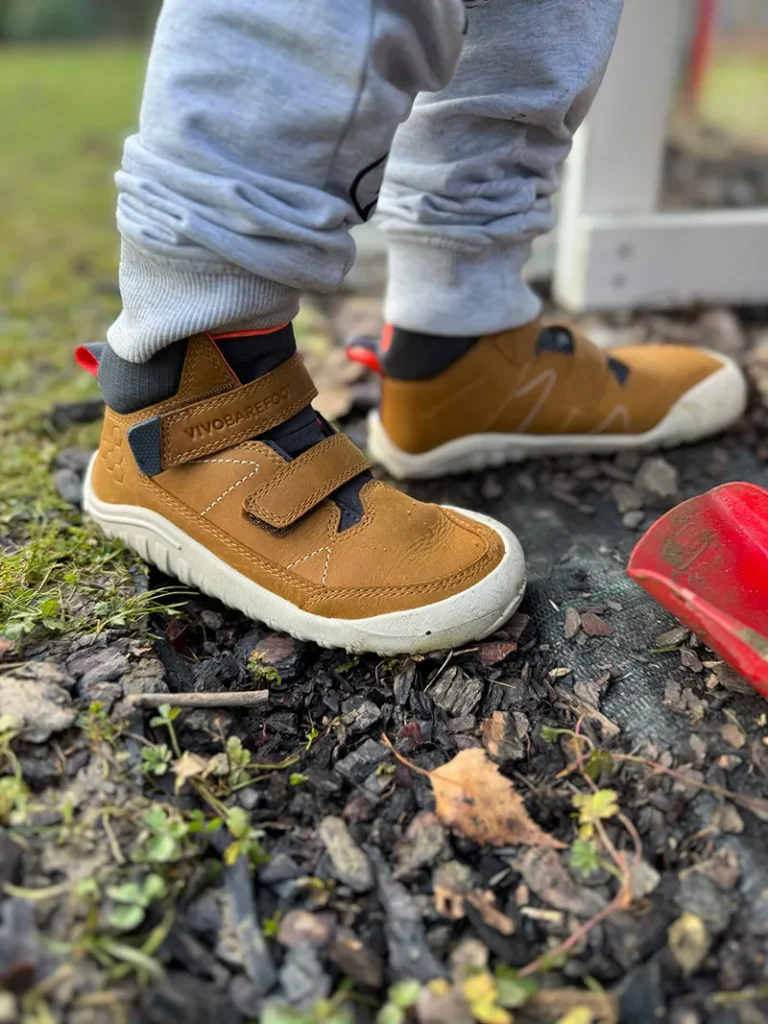
Models: Tracker, Primus Trail, Explore
Why we like them: Durable, flexible, and fully barefoot. Great grip and water-resistant options available.
Fit: Best for narrow and medium-width feet, with a stronger slope toward the pinky toe.
Use BU15 for 15% discount
Saguaro Kids
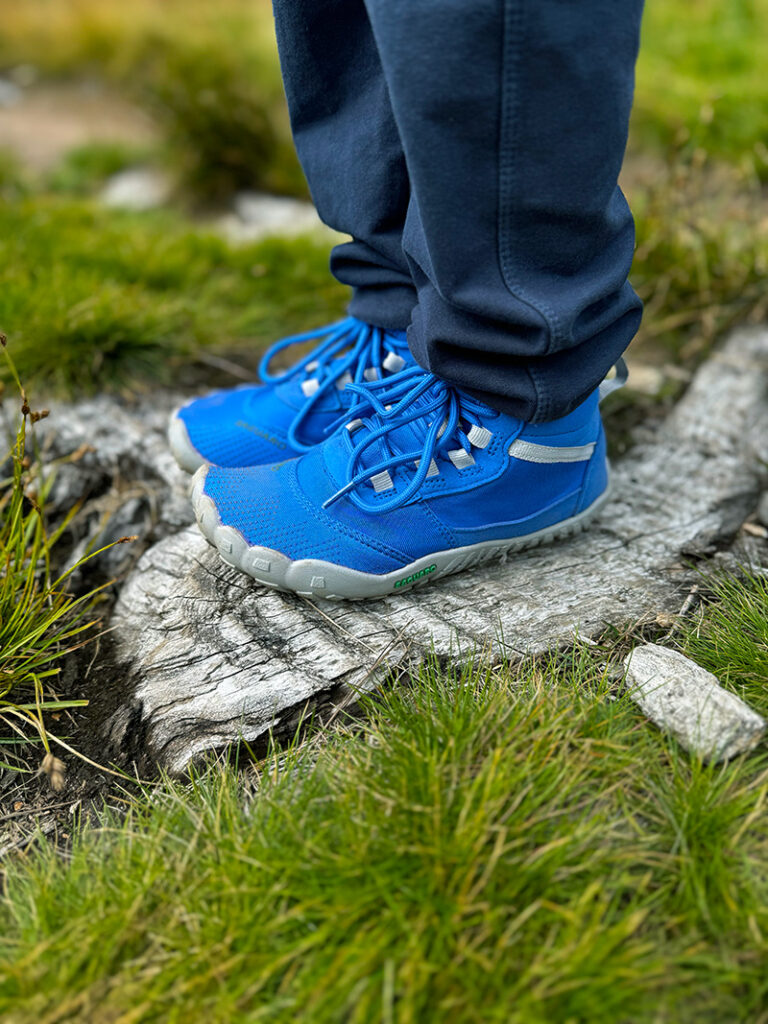
Models: Will II Lite, Vitality I, Fast I, Forestep I, Brave I
Why we like them: One of the most affordable barefoot options for kids – perfect for families just getting started. They offer a range of waterproof and breathable models with flexible soles and a roomy, foot-shaped design.
Fit: Great for medium and wide feet, and available in fun colors kids love.
Use BU15 for 15% discount
Freet
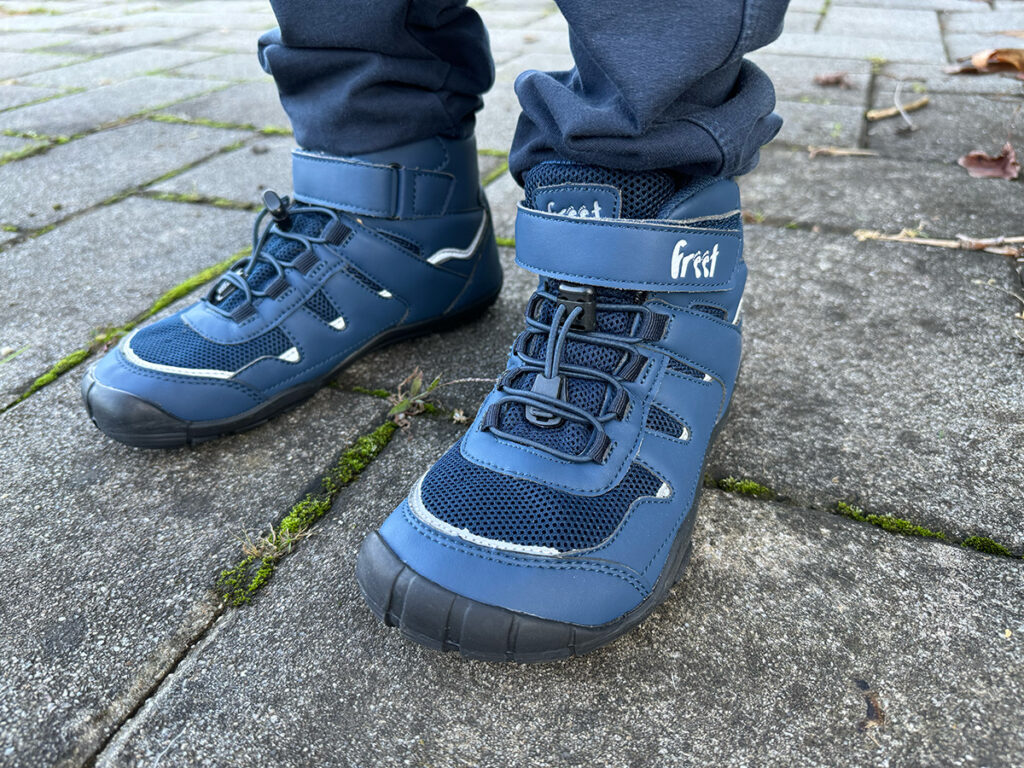
Models: Tufee and Flex Junior
Why we like them: Soft, barefoot-friendly hiking shoe with great grip and flexibility.
Fit: Suitable for medium and wide feet (Tuffee feels narrower than the Flex Junior model)
Use code bu-freet for 10% discount
Ballop
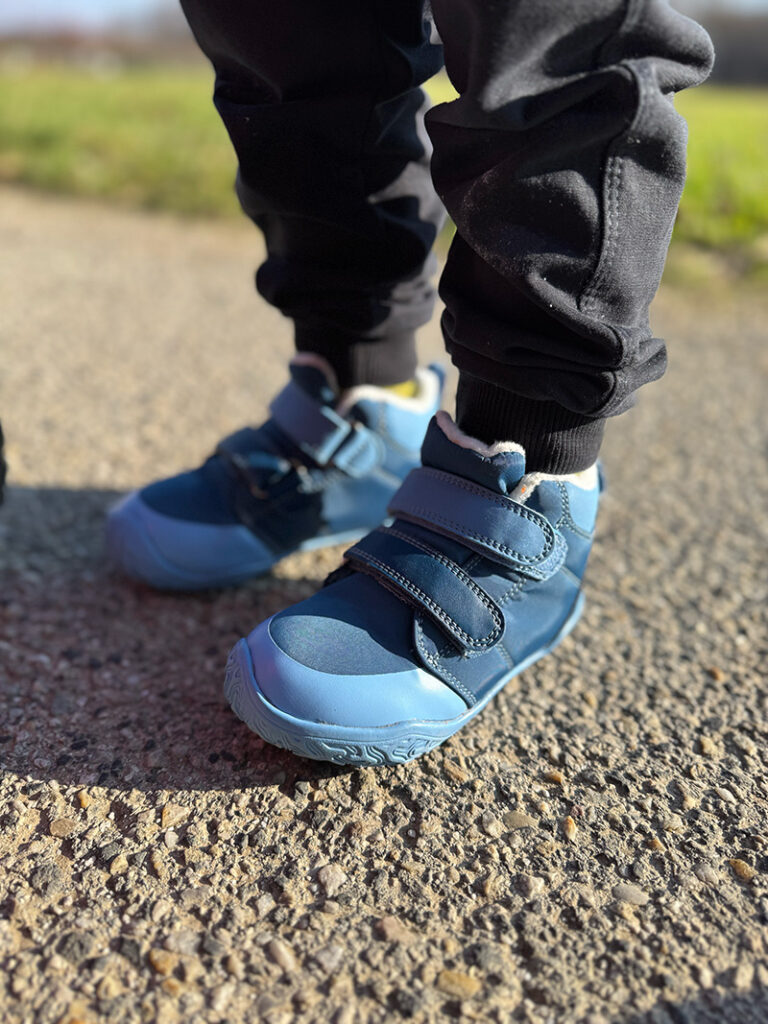
Why we like them: Good budget-friendly barefoot shoe for hikes and everyday play.
Fit: Narrow and medium-width feet, average volume.
Use BU10 for 15% discount
Tips for Choosing Barefoot Hiking Shoes for Kids:
- Prioritize ankle mobility – avoid stiff, high-cut boots unless necessary
- Look for grippy soles for slippery or muddy terrain
- Measure their feet regularly (they grow fast!)
- Choose a model with extra toe space for comfort on long walks
- Waterproof models are great, but breathable shoes are usually more comfortable in warm weather
How to Choose the Right Pair for You
Here are a few tips to help you decide which barefoot hiking shoes are best for your needs:
| Need | Go With |
|---|---|
| Waterproof + Rugged | Vivobarefoot Tracker, Freet Mudee, Xero Scrambler Mid WP, Ahinsa Hiker |
| Light + Breathable | Freet Feldom, Xero Shoes Scrambler, Be Lenka Trailwalker |
| Extra Wide Feet | Realfoot Trekker, Softstar Switchback, Proalp Contact S2, Ahinsa Hiker xWide |
| Vegan Preference | Ahinsa Shoes, Ballop, Saguaro, Xero Shoes, VIVOBAREFOOT |
| Cold-Weather Ready | Lems Boulder Summit, VIVOBAREFOOT Tracker, Be Lenka Ranger, Freet Mudee |
| Beginner-Friendly (More Cushion) | Lems, Bahé Revive, Xero Shoes Ridgeway, Barebarics |
| Budget-Friendly Options | Saguaro, Ballop |
| Thinnest Ground Feel | Ahinsa Chitra, Saltic Vintero, Be Lenka Trailwalker (without insole), |
| Medium Ground Feel (Best Balance) | VIVOBAREFOOT Tracker, Freet Bootee, Proalp Contact S2, Bär Mountain Barefoot |
Last Updated: April 3, 2025
- Added Bahé, Barebarics, Saltic, and Saguaro to expand the list with more affordable, structured, and beginner-friendly barefoot hiking options
- Expanded the Sizing & Fit details for each brand to give clearer guidance on width, volume, and toe space
- Grouped all shoes and boots by sole thickness (medium, ultra-thin, and cushioned wide toe box options) to make it easier to find your ideal fit and feel
- Added a new FAQ section to address common hiking-related questions
- Refreshed all brand descriptions with the latest models, performance insights, and updated product photos
- Updated the comparison table and our “How to Choose” chart for easier navigation
Original Testing: August 18, 2023
FAQ: Barefoot Hiking Shoes & Boots
1. Are barefoot shoes good for hiking?
Yes, when chosen wisely. Barefoot hiking shoes promote natural movement, improve foot strength, and increase ground feel, which can help with balance and coordination. However, they require an adaptation period if you’re used to supportive footwear. If you’re new to barefoot hiking, start slow and check out our beginner’s guide.
2. Can I wear barefoot shoes on rocky or uneven terrain?
You can, but it depends on the model and your experience. Shoes with slightly thicker soles or added protection (like the Vivobarefoot Tracker or Freet Impala) are better for rocky paths. Ultra-thin models are best for forest trails or soft ground.
3. Do barefoot hiking boots have enough grip?
Yes, most quality barefoot hiking shoes and boots have deep lugs and grippy outsoles designed for trail conditions. For wet or slippery terrain, look for options with Michelin or Vibram soles.
4. Will I get sore feet or blisters when switching to barefoot hiking?
You might, especially if you jump into long hikes right away. Barefoot shoes activate muscles that haven’t been used much in traditional footwear. Start with short hikes and gradually build up strength. A proper fit is also key to avoiding blisters.
5. Are barefoot hiking shoes waterproof?
Some are, and some aren’t. Models like the Vivobarefoot Tracker, Xero Scrambler Mid WP, and Ahinsa Hiker offer waterproof protection. Others focus on breathability. You can also improve water resistance with sprays or waxes – especially for leather models.
6. Can beginners wear barefoot hiking boots?
Absolutely, but start slow. Beginners may prefer models with more cushioning or protection (like Lems or Bahé) while transitioning. Thinner options can come later as your feet get stronger.
7. How much toe space should barefoot hiking boots have?
Aim for at least 12–15 mm of space in front of your toes, especially if you’re going downhill or wearing thicker socks. This prevents toe bumping and allows natural toe splay.
8. Do I need toe socks with barefoot hiking shoes?
Not necessarily. Toe socks can help keep toes aligned and reduce friction between them, especially on long hikes. But wide toe box regular socks work just fine too – just make sure they don’t squish your toes.
9. How do I know which barefoot hiking shoes will fit my feet?
It depends on foot width, volume, and shape. We recommend taking our Foot Width Quiz to find the brands and models that match your foot type best. Also, check our sizing & fit notes under each brand in this post.
10. Can kids hike in barefoot shoes too?
Definitely! There are great barefoot hiking options for kids (like Vivobarefoot, Freet, and Saguaro) that allow natural movement and help develop strong, stable feet from a young age.
Final Thoughts: Hike Naturally, But Wisely
Barefoot hiking is a powerful way to reconnect with your body, your feet, and the trail beneath you – but only if you’re wearing the right pair. Each brand listed above respects the natural foot shape and lets your toes spread and flex as they were designed to.
Start slow, pick a pair that suits your trail needs and foot shape, and enjoy hiking in a way that actually feels like freedom.
Want More Help Finding Your Fit?
Take our Foot Width Quiz to find the best barefoot shoes for your specific foot shape – and don’t forget to check out our comparison photos showing how different brands vary in width, shape, and proportions.
Have you tried barefoot hiking? Got a favorite pair? Drop it in the comments – we’d love to hear what works for your feet.


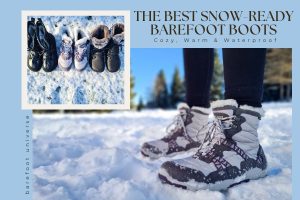
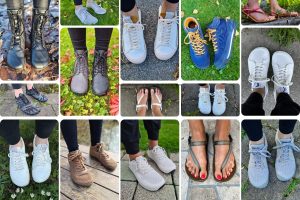
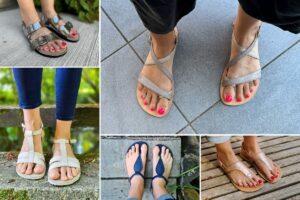


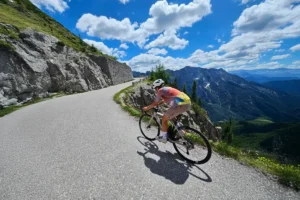
Hello,
how does the Realfoot Toebox compare to Softstar? Especially the Primal Sawyer or similiar models? I own the Realfoot City Jungle but had to size up because the taper is too aggressive for my pinky. It doesn’t have enough space in front of the toe, even though I left 12 mm space in front of my longest toe.
The Softstar Primal Sawyer seems to have less taper, but maybe the pictures deceive.
Cheers
Hi Chris, we cannot directly compare it to the Softstar Primal Sawyer as we don’t have it, but we can compare it to the Softstar Switchback boots. There is more vertical space in the Realfoot Trekker than in the Softstar Switchback, and therefore, the Realfoot feels wider than the Softstar, even though the outsole shape is almost the same in the toe area. I have more space for my pinky toe in the Realfoot. Hope this helps!
Hi Katja,
thanks for your fast response. That was helpful and saves me from trying out Softstar then, since I already had to size up the Realfoot because of missing pinky space.
Since you already tested the barefoot+ Models from Groundies: how do they compare space wise to Realfoot shoes, especially for the pinky toes?
Going purely by the numbers the Groundies look less wide (even if I add the 5mm you mention in your review), and the taper on the pinky seems more aggressive (so easier to touch the front with the pinky toe). Is that correct?
Hi Chris, Groundies Barefoot+ are not as wide as Realfoot. I have much more space for my pinky toe in Realfoot than in Groundies. However, Groundies are slightly wider in the midfoot and heel parts.
Do you have any favorite picks that work well on slick granite? My hikes combine all sorts of elements and I still haven’t found shoes that I’m comfortable on wet rock in… (and or ice for winter city walking)
Hi Meredith,
Honestly, slick granite and ice are some of the trickiest surfaces for any shoe. I’ve found that soles with sticky rubber (like Vibram Megagrip) tend to give the best grip on wet rock, though no shoe will feel 100% secure there. For winter walking on ice, I’d really recommend using additional traction like microspikes, since even the grippiest rubber can’t fully handle ice on its own.